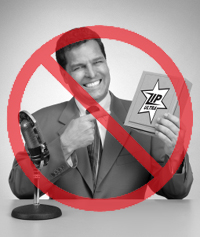How To Sell Books: The Right Way – The Wrong Way
Book marketing is a difficult task for some people. There is a ton of free information out there that, when put to the test, simply does not produce sales. Oh yes, it all sounds good and seems to make sense. However many people find that the sales just don’t happen. Why not?
Often it is because the information presented is not based in reality.
Book Marketing Hype
 We know that people spend a ton of money on the next ‘hot’ weight loss product and never lose a pound. In the same manner, many authors spend money on the next ‘hot’ book marketing idea and never sell a book. Sadly many of us fall for the hype. It’s human nature. We LIKE to think that somebody out there has a magical solution or some kind of ‘secret’ approach or technique. But when we fall for that hype and spend time or money on that seemingly magical solution, it doesn’t work.
We know that people spend a ton of money on the next ‘hot’ weight loss product and never lose a pound. In the same manner, many authors spend money on the next ‘hot’ book marketing idea and never sell a book. Sadly many of us fall for the hype. It’s human nature. We LIKE to think that somebody out there has a magical solution or some kind of ‘secret’ approach or technique. But when we fall for that hype and spend time or money on that seemingly magical solution, it doesn’t work.
But guess what? There are no secret methods. There are no shortcuts. There is no magical solution. Most of these ‘hot ideas’ succeed in but one thing – they separate you from your money.
Doing The Wrong Thing
The best and most sincere efforts will produce nothing if you are doing the wrong things. It is very possible to work very hard all day doing things that won’t work. If you try to win a stock car race while riding a bicycle, you’ll expend a lot of effort but will likely not win. If you try to dig a well using a teaspoon, a lot of work will be done, but there will be very little progress made.
How can you tell you are doing the ‘right’ things? Look at your sales. If you are working hard and getting no results, you are probably doing the wrong things.
What Works?
What does work? The answer is, and always has been, a professional level strategic marketing approach based in reality.
Without a laser sharp, professional level targeted marketing strategy, the best of tools will likely fail, as it is the strategy that causes the tool to work, not the other way around. So let’s look at a few of those basics.
The Basics
1. Your Target Audience
 To be successful you must know your target audience. If you don’t know your audience you can’t possibly know what they are looking for, and therefore you will not be able to offer a targeted message that will allow them to understand that YOU have what they’re looking for. I never cease to be amazed by the number of people who start off with “BUY MY BOOK NOW!” When was last time you bought something because somebody screamed “BUY THIS NOW!”?
To be successful you must know your target audience. If you don’t know your audience you can’t possibly know what they are looking for, and therefore you will not be able to offer a targeted message that will allow them to understand that YOU have what they’re looking for. I never cease to be amazed by the number of people who start off with “BUY MY BOOK NOW!” When was last time you bought something because somebody screamed “BUY THIS NOW!”?
Never. We buy something because it fills our needs as we perceive those needs.
If we don’t research and understand the target audience we will not know WHO they are, we will not know HOW to reach them, we will not know WHERE they are, we cannot MOTIVATE them, we cannot even begin to approach them with a message that will resonate with them. Guessing doesn’t work. Yelling, telling and selling is so much noise.
2. Know The Competition.
 It used to be the competition was limited as there are only so many books on a shelf in a bookstore. That is not the case anymore. Every single book in existence is now available, right there, with the click of a mouse, on someone’s PC phone or tablet. Your potential buyer can find a zillion other books with one single click. Not some of them – every one of them. Therefore you are competing with every other book out there, all just one click away.
It used to be the competition was limited as there are only so many books on a shelf in a bookstore. That is not the case anymore. Every single book in existence is now available, right there, with the click of a mouse, on someone’s PC phone or tablet. Your potential buyer can find a zillion other books with one single click. Not some of them – every one of them. Therefore you are competing with every other book out there, all just one click away.
Communication to a target audience in the form of a specifically targeted message is of utmost importance. That message is not “BUY MY BOOK NOW!”
Segmentation is vitally important. There is no “one-size-fits-all” message that will suffice for everyone.
An 18 year old female will not respond to messages designed for 50 year old male. Nor will a 50 year old male respond to message designed for an 18 year old female. Market segmentation and the development of the specific messages for each segment of that total target audience are the key to getting an audience to respond.
3. Website
A web site is just a web site. Anybody can put up a web site (and it is often glaringly evident when someone has done that). A web site is not a brochure. It is instead a store. It is the place where your visitors are converted to sales. All the elements that will cause that visitor to convert to a sale – branding language, positioning, benefits language, non-threatening calls to action and all the other important components must be in place. This is what will turn visitors into buyers.
4. Engagement Through Permission Based Marketing
 In the real world we buy from vendors, stores and individuals as the result of advertising or word of mouth. On the web it’s different. The web marketing model revolves around ‘permission based marketing’. This means your visitors give you permission to contact them with marketing information.
In the real world we buy from vendors, stores and individuals as the result of advertising or word of mouth. On the web it’s different. The web marketing model revolves around ‘permission based marketing’. This means your visitors give you permission to contact them with marketing information.
The goal is to get visitors to opt in to a list created through presenting non-threatening calls to action. A non-threatening call to action asks the buyer to exchange their e-mail address for something of value. But that “something of value” must be something that demonstrates they are really interested in buying a book. If you give away an IPad everybody’s going to sign up. That does not mean they want to buy a book. Studies have shown that permission based marketing is THE concept that works to create sales long-term in the digital environment. If you’re not using this, you’re most likely to spinning your wheels and accomplishing very little.
5. Word Of Mouth
Nothing sells anything like word of mouth. That is especially true for books. The final goal underlying all book marketing efforts is to create that word of mouth. But word of mouth CANNOT happen unless you first have buyers. It is the list of buyers that is used to encourage word of mouth. Without a list you’re relying and good luck and fortune. That’s not a good strategy.
6. Market To The Goal
 This is the most basic of ideas, yet it the one most people simply skip over. It is imperative that you have a sales goal. The goal must be realistic and achievable. The goal will determine the efforts you will make and will allow you to judge how well those efforts are paying off. If you don’t have a goal you will flounder about endlessly with nothing against which to judge whether or not you are being successful. It is the marketing goal that determines the who, what, where, why and how of the overall marketing strategy.
This is the most basic of ideas, yet it the one most people simply skip over. It is imperative that you have a sales goal. The goal must be realistic and achievable. The goal will determine the efforts you will make and will allow you to judge how well those efforts are paying off. If you don’t have a goal you will flounder about endlessly with nothing against which to judge whether or not you are being successful. It is the marketing goal that determines the who, what, where, why and how of the overall marketing strategy.
Work Smarter, Not Harder
None of this is brain surgery. It is real world marketing based in reality. It’s simple, but it is not easy. Without a realistic marketing strategy, your book will likely end up being a statistic. It is the marketing strategy that will get your book noticed by your target audience and help you avoid having a book that is virtually invisible to today’s Internet audience.
Get your free marketing analysis here. This analysis will cover all the bases and will help you take your book marketing efforts to the next level